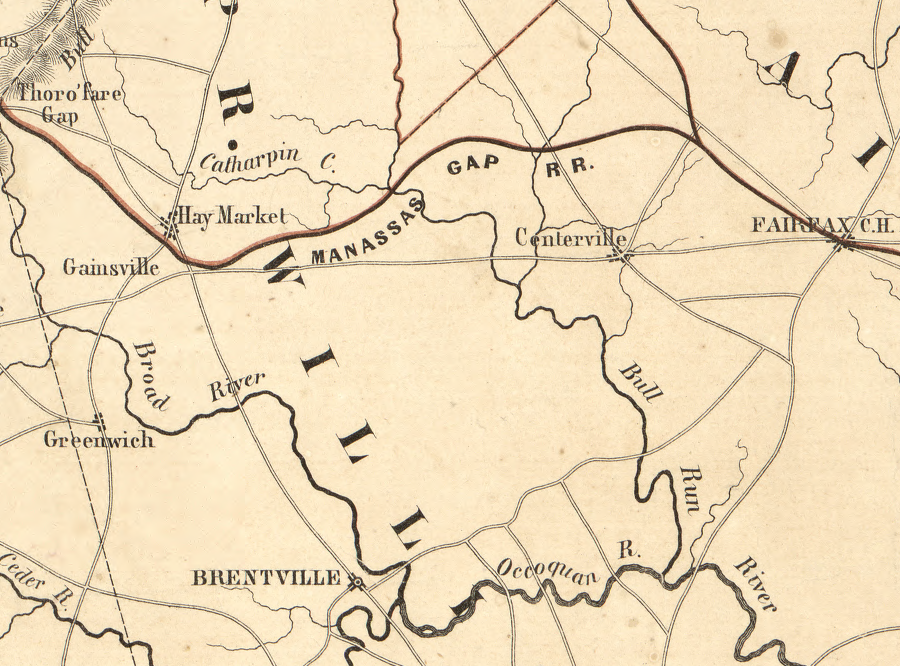
in 1855, the Manassas Gap Railroad had no plans to develop any town at a junction with the Orange and Alexandria Railroad
Source: Library of Congress, Map of the Manassas Gap Railroad and its extensions; September, 1855

in 1855, the Manassas Gap Railroad had no plans to develop any town at a junction with the Orange and Alexandria Railroad
Source: Library of Congress, Map of the Manassas Gap Railroad and its extensions; September, 1855
Some cities and towns, such as Manassas, Roanoke, and Crewe, developed from scratch because of a railroad. Others, such as Petersburg and Keysville, existed prior to the arrival of a railroad and simply expanded as the railroad facilitated transportation.
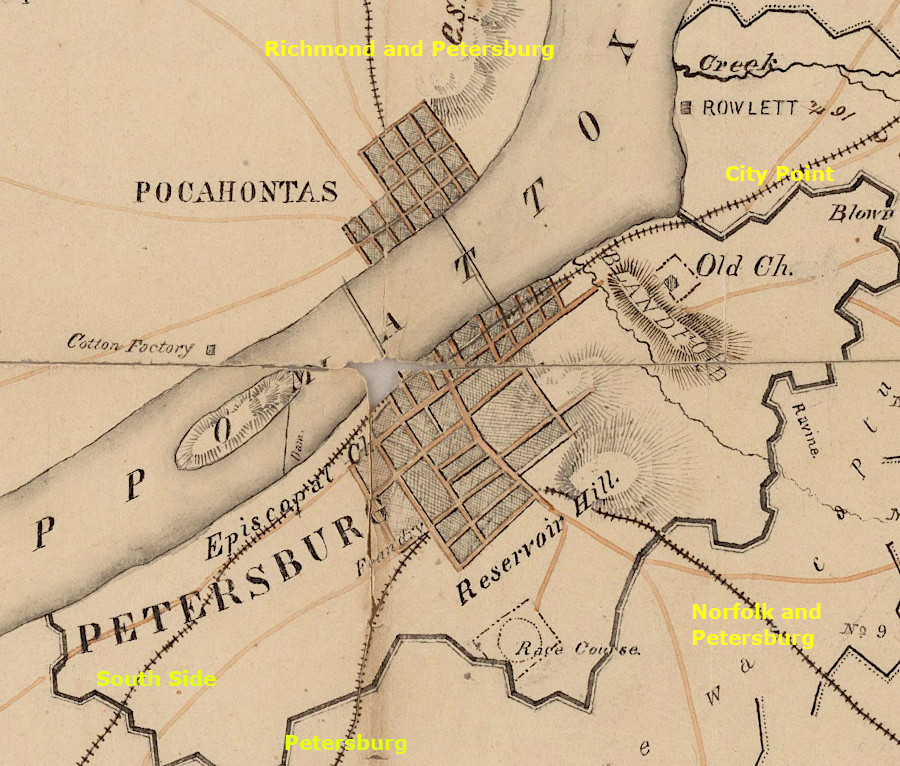
Petersburg grew initially as a Fall Line port city, but had five railroads prior to the start of the Civil War
Source: National Archives, Map of the Manassas Gap Railroad and its extensions; September, 1855
Manassas owes its existence to the Manassas Gap Railroad and the Orange and Alexandria Railroad. The site was nondescript farmland until the two railroads created Manassas Junction.
There was no intention to create a city there; the junction could been a temporary connection, or a minor spot on the rail network in the 1850's. The Manassas Gap Railroad had graded a level roadbed for an Independent Line to eliminate the need to use the Orange and Alexandria Railroad before the Panic of 1857 required a reduction in expenses. Costs for construction of 25 miles of Independent Line track were reduced by the decision to continue to pay for trackage rights on the Orange and Alexandria Railroad.
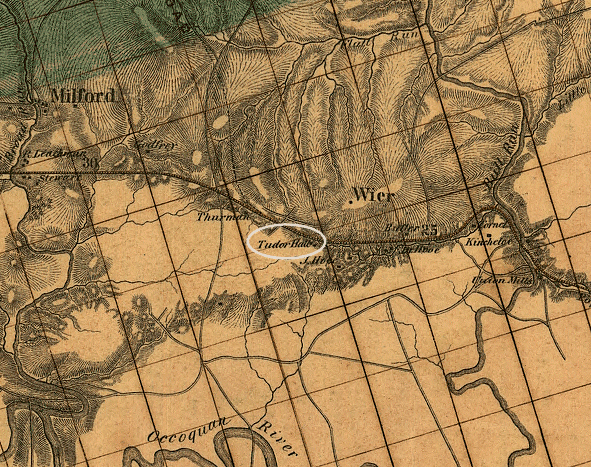
Orange and Alexandria Railroad route south of Bull Run (before "Tudor Hall" evolved into Manassas)
Source: Library of Congress, Map and profile of the Orange and Alexandria Rail Road
In the Civil War, the depot at Manassas Junction there became strategically important. Confederates burned the facilities at the Manassas Junction in March, 1862. In August of 1862, after the Yankees had built new warehouses, Confederates burned them again. During the Overland Campaign of 1864-64, when Grant finally captured Richmond, the site of the railroad intersection was largely abandoned.
After the Civil War, the two railroads merged and plans for constructing an Independent Line were dropped. The site where the Orange and Alexandria Railroad met the Manassas Gap Railroad developed into a small community based on the railroad.
The General Assembly approved a town charter in 1875. After years of agitation, town residents managed to get the county seat moved from Brentsville to Manassas in 1894. Brentsville had been bypassed by the Orange and Alexandria Railroad because it was on a topographically high spot, and railroads were constructed to avoid hills wherever possible. Unlike Warrenton in Fauquier County, Brentsville was unable to get a spur line built to the county seat. In the end, the new town with the railroad (Manassas) thrived and the old town without the railroad (Brentsville) faded away.1
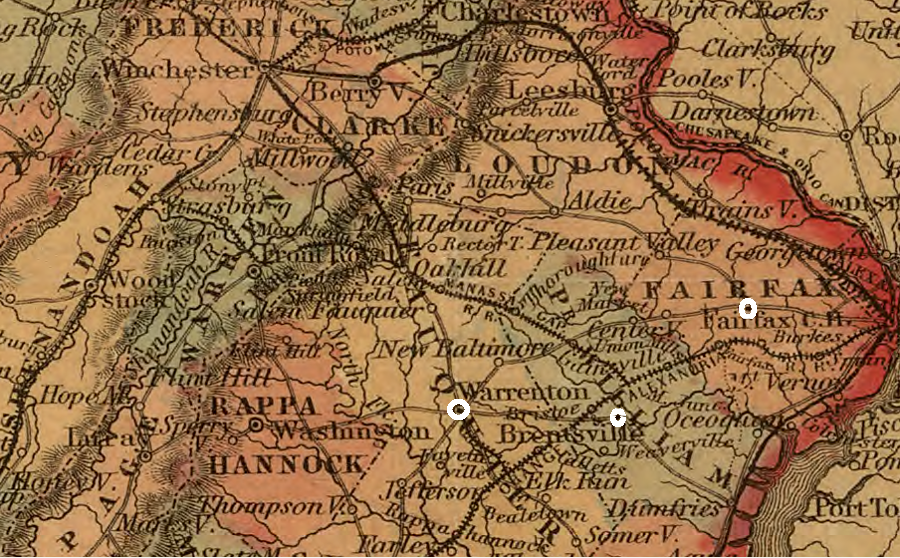
in the 1850's the Orange and Alexandria Railroad bypassed the county seats of Fairfax, Prince William, and Fauquier counties in order to build track on a more-level ground, and only Warrenton justified building a spur track
Source: Library of Congress, Colton's Virginia (by J. H. Colton, 1855)
Some cities grew because the railroad needed a watering or fueling station. The Norfolk and Petersburg Railroad cut a straight line though thinly-settled farm- and timberland northwest of Suffolk. Though settled by English colonists in the early 1600's, most of the land was beyond the watershed divide of the James River. There was limited ability to ship crops by water to export via the Chesapeake Bay, and the road network was sparse.
Gordonsville was the original end of the line of the Louisa Railroad in 1840, carrying cargo and passengers from the Piedmont to the junction with the Richmond, Fredericksburg and Potomac (RF&P) Railroad near Hanover Court House. In 1850, the rails were extended west to Charlottesville. Another extension on the eastern end created a connection to Richmond, and the newly-renamed Virginia Central Railroad no longer needed to pay for use of the Richmond, Fredericksburg and Potomac Railroad track to reach that port city. The junction of the two railroads near Hanover Court House, originally Taylorsville and now known as Doswell, never grew into a significant town.
The Orange and Alexandria Railroad made both Gordonsville and Charlottesville into railroad junctions in 1854. The charter from the General Assembly required the Orange and Alexandria Railroad to use a segment of Virginia Central track to go between Gordonsville and Charlottesville.
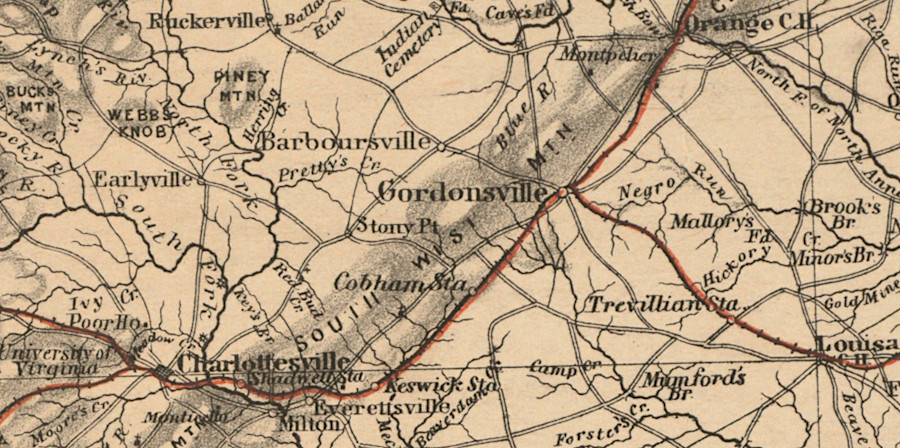
both Gordonsville and Charlottesville was originally junctions of the Orange and Alexandria and the Virginia Central railroads
Source: Norman B. Leventhal Map & Education Center Collection, Middle Virginia and North Carolina (1864)
In 1876, the Orange and Alexandria had been consolidated into the Washington City, Virginia Midland and Great Southern Railroad. It was controlled by the Baltimore and Ohio Railroad, which feared a competitor owning the track between Gordonsville and Charlottesville would block used its use. The Baltimore and Ohio Railroad used is influence in the General Assembly to get authorization to build separate track. It started construction on the eastern end at Orange rather than Gordonsville, in part to reduce construction through hilly terrain and in part to attract business from a different part of the Piedmont. As a result, the town of Orange became a new railroad junction and Gordonsville lost that status.2
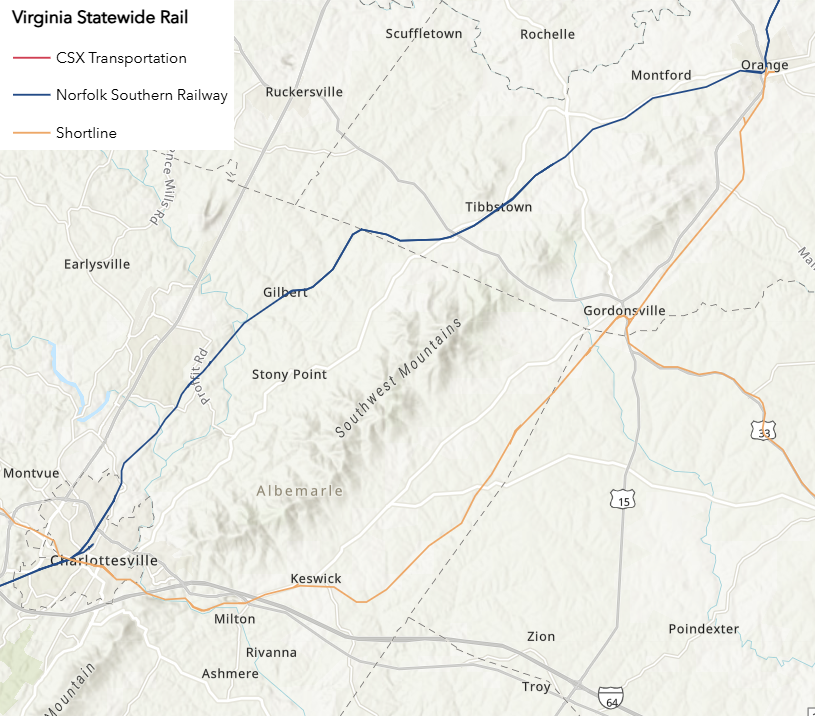
separate railroads today, successors to the competing Orange and Alexandria and the Virginia Central railroads, now have separate tracks between Orange and Gordonsville
Source: Virginia Department of Rail and Public Transportation (DRPT), DRPT Rail Database
The Norfolk and Petersburg Railroad spurred development of small towns, since it needed to resupply fuel and water for steam engines. Many were reportedly named by the chief engineer of the railroad William Mahone and his wife Otelia after being inspired by British author Sir Walter Scott. Waverley and Ivor were characters in his books, Windsor was Scott's birthplace, and Wakefield was in the title of a book Scott particularly admired.
Local lore claims Disputanta got its name because the married couple got into a dispute and could not agree on a name for the depot. However, no one knows the origin of the name for the community of Zuni.3
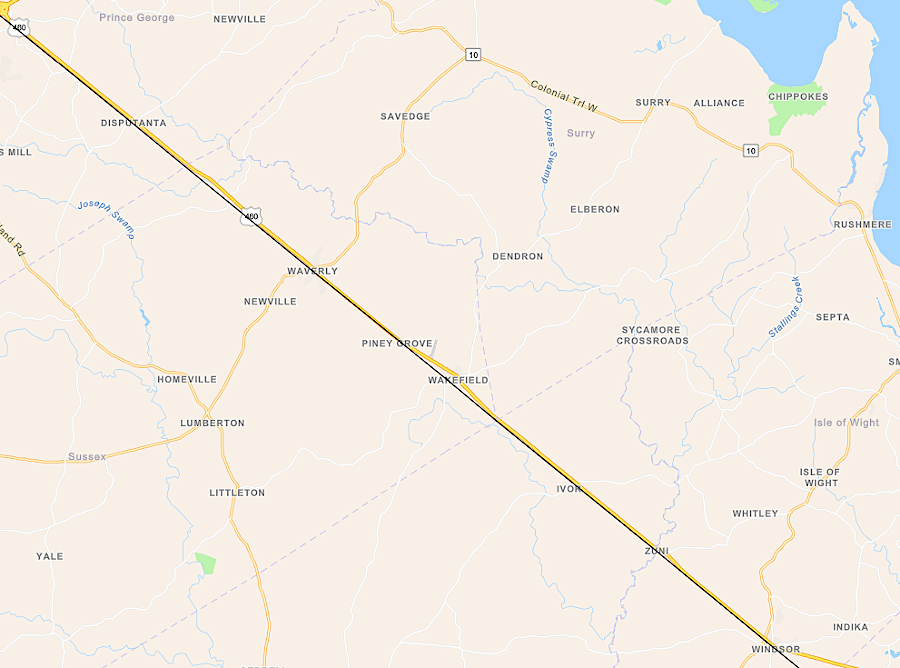
the Norfolk and Petersburg Railroad created towns between Suffolk and Petersburg
Source: ESRI, ArcGIS Online
The James River and Dismal Swamp constrained the options for linking the port cities on the Elizabeth River with inland Virginia, west of the Fall Line. Nearly every railroad serving Portsmouth and Norfolk built through Suffolk, with multiple connections to different terminals on the river.
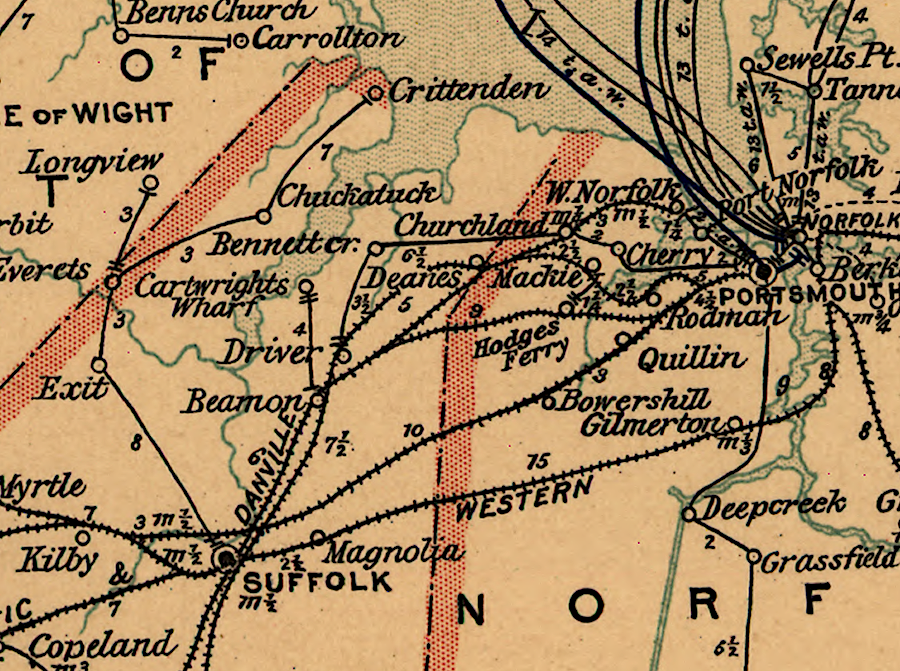
in 1896, multiple railroads had built through Suffolk to Portsmouth/Norfolk
Source: Library of Congress, Post route map of the state of Virginia and West Virginia (1896)
When a railroad arrived at an existing city transportation costs dropped. Farm goods could be shipped to the city for processing, if waterpower was available to energize mill wheels and factory machines. Lynchburg emerged as a manufacturing center processing tobacco. In 1848, it could ship via the James River and Kanawha Canal, Alexandria and Orange Railroad, South Side Railroad, and Virginia and Tennessee Railroad as well as by local roads.
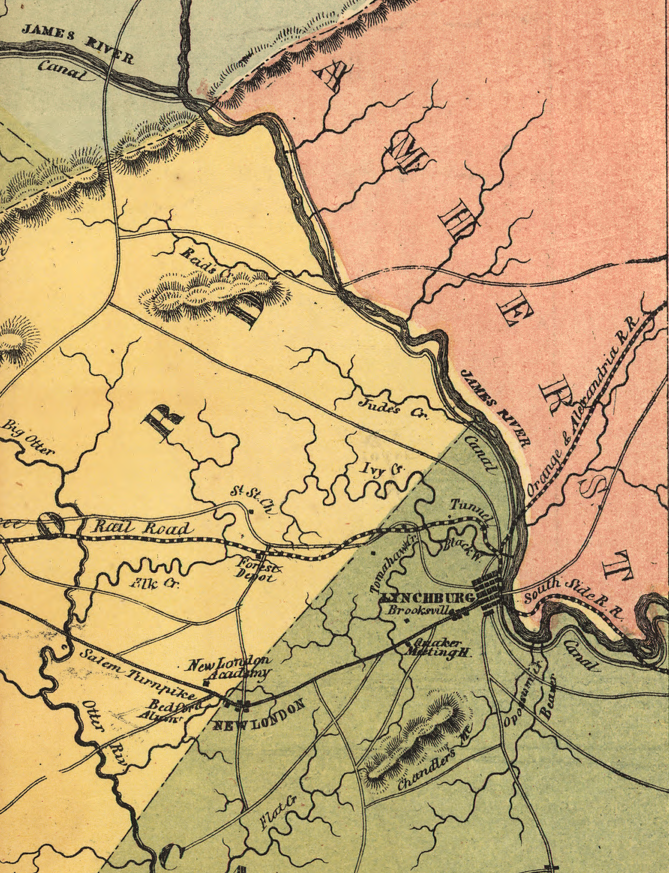
Lynchburg grew from a ferry crossing on the Jame River into a well-connected manufacturing center
Source: Library of Congress, Map & profile of the Virginia & Tennessee Rail Road (1848)
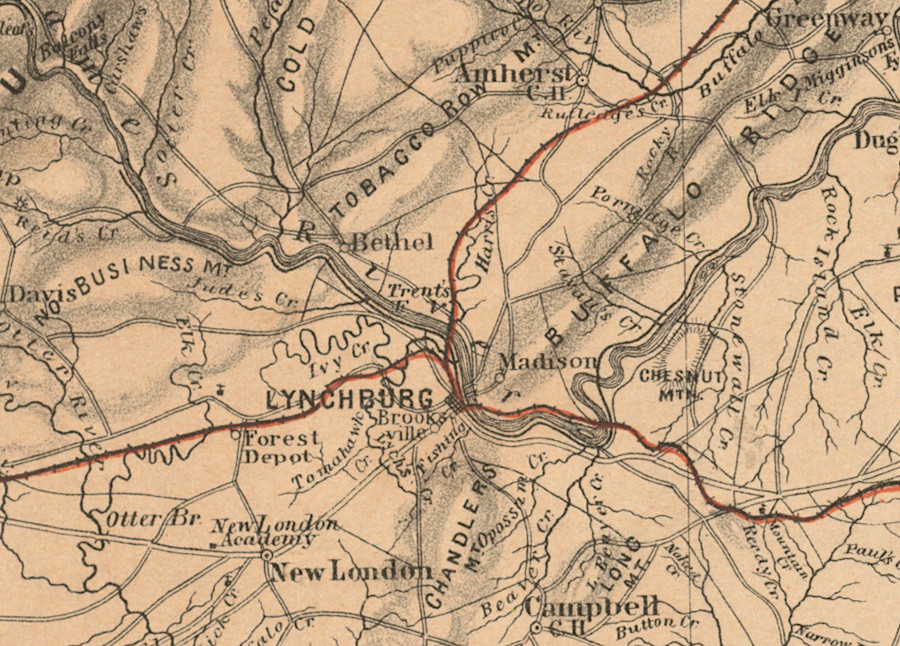
at the start of the Civil War, three railroads connected Lynchburg to Alexandria, Petersburg, and Bristol
Source: Norman B. Leventhal Map & Education Center Collection, Middle Virginia and North Carolina (1864)
Not all railroad junctions grew into metropolitan centers. The South Side Railroad and the Richmond and Danville Railroad met at Burkeville, but the small town has always stayed small. Crewe was created at the midpoint of the Norfolk and Western Railroad, to repair the steam locomotives carrying coal from West Virginia to Norfolk. Crewe thrived until diesel replaced coal as the fuel for locomotives in the 1950's, reducing the number of railroad facilities needed to add water and maintain steam engines.
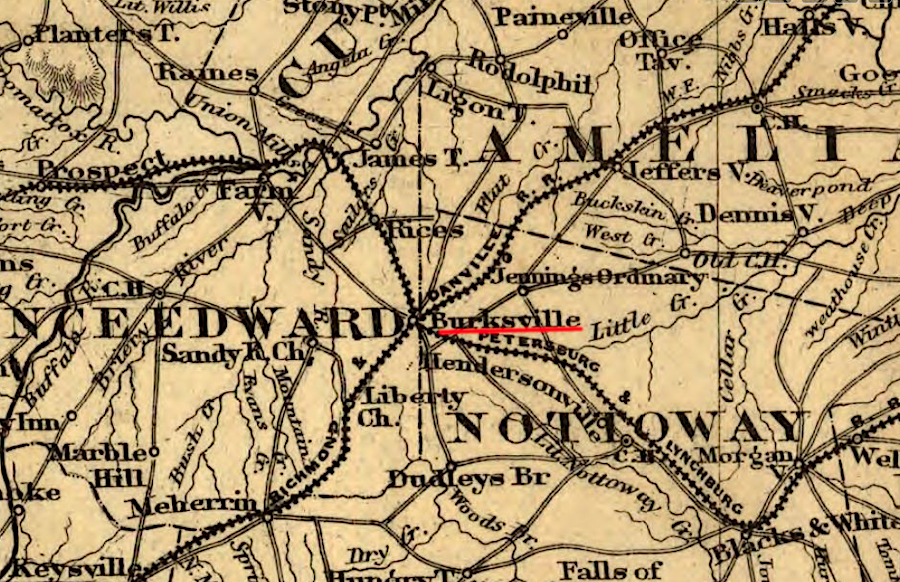
Burkeville never grew into a major town, even though it was a railroad junction
Source: Library of Congress, Map showing the Fredericksburg & Gordonsville Rail Road of Virginia (1869)
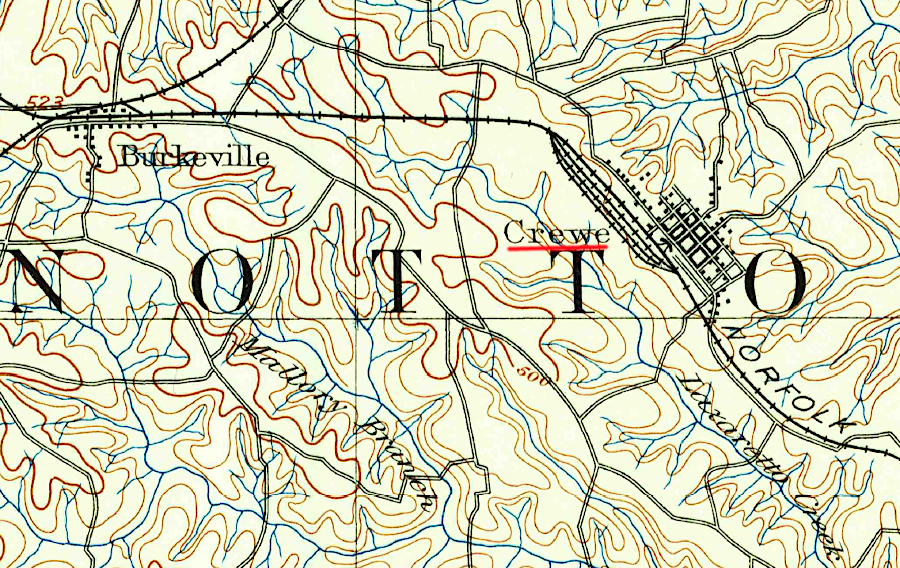
Crewe was created as a locomotive repair facility by the Norfolk and Western Railroad
Source: US Geological Survey (USGS), Farmville VA 1:125,000 topographic quadrangle (1893)
Roanoke was the last large city to develop in Virginia. It grew as a "central place" after the landowners around Big Lick decided they wanted the Shenandoah Valley Railroad to intersect the Norfolk and Western (the former Virginia and Tennessee) at their location. Nearby Salem was not interested in becoming a rowdy railroad town, but the Big Lick landowners just downstream on the Roanoke River welcomed the economic stimulus of the railroad business.4
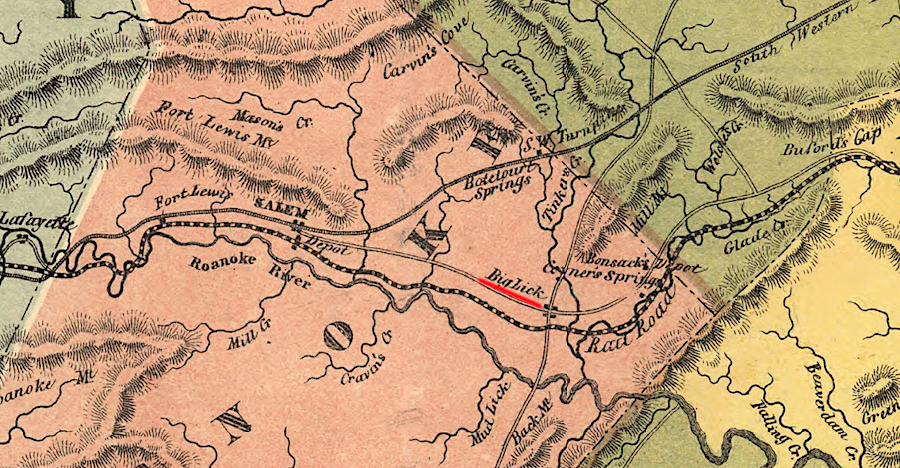
the Virginia & Tennessee Railroad stimulated development at Salem; Big Lick did not grow until the Shenandoah Valley Railroad arrived in 1881
Source: Library of Congress, Map & profile of the Virginia & Tennessee Rail Road (1848)
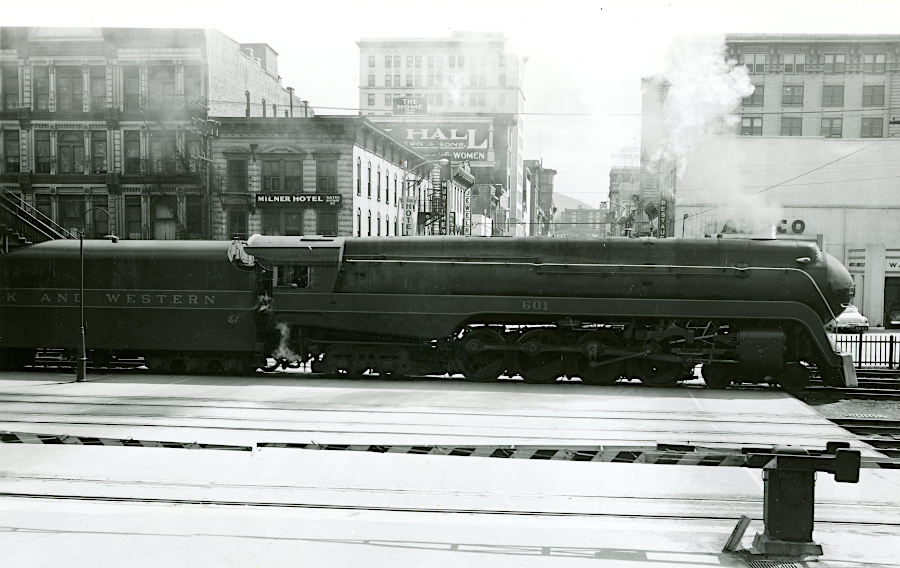
J class locomotive, a streamlined steam engine, at Roanoke
Source: National Archives, Locomotive of the N&W Railroad, Roanoke, Virginia (March 30, 1951)
West of the Blue Ridge, no railroad crossed the watershed divide of the James and Potomac rivers until after the Civil War. Pre-war Virginia politicians blocked projects that would steer trade to Baltimore rather than Richmond, Petersburg, Norfolk, or Alexandria. After the war, Northern financiers had sufficient economic leverage and political influence in the General Assembly to build a new north/south railroad and merge it into the Norfolk and Western in 1881-2.
The junction of the railroads could have been located as far east as Bedford or even Lynchburg, but economically it made sense to reduce the mileage of parallel track and unite the lines west of the Roanoke River water gap through the Blue Ridge. So topography, as well as politics, determined where the junction would occur.
Had the railroad been limited to just the farm trade of the Shenandoah Valley and Southwest Virginia, Roanoke may never have grown into a city of 100,000 people. Its growth is attributable to the development of the rich coal veins of the Appalachian Plateau in West Virginia and Tazewell, Buchanan, Dickinson, and Wise counties in Virginia. Demand was so great that at Pocahontas, the coal was mined and stockpiled on the route of the railroad in advance of the tracks being laid down and trains arriving in 1883. The Norfolk and Western RR located its locomotive manufacturing and repair shops in Roanoke, and the city grew so rapidly that it was knows as the "Magic City" at the turn of the century (1900).
In contrast, the population of Manassas did not boom, and few railroad workers lived there. Manassas had a crew change facility and a depot, but the railroad repair facilities were in Alexandria.
In 2018, with population swelling as the city has been "swallowed" by the Washington megalopolis, the population of Manassas remained half that of Roanoke. Manassas remained a town until 1975, when it obtained a city charter. The major employer at the time was IBM, which hired mostly white-collar rather than blue-collar workers. Because there were so few industrial laborers in Manassas, the city's politics have been substantially different from that of Roanoke.
Leadership in Manassas was part of the Byrd Organization until the 1970's. Manassas shifted from a town to city status in 1975, two years after the state parties finally aligned with their national parties, and Virginia Republicans finally identified themselves as the "conservative" alternative to "liberal" Democrats. The Manassas City Council elected Republicans and Independents, but no one who campaigned as a Democrat won a seat on the Manassas City Council from 1975 until the 2014 election.
Roanoke has been much more of a blue-collar union town, reflecting its manufacturing heritage. That city has consistently recorded a strong Democratic majority in elections.
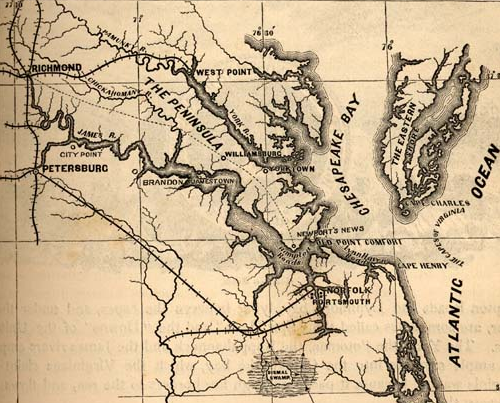
Newport News developed as an urban center after the Chesapeake and Ohio Railroad was extended from Richmond
Source: University of North Carolina, The Great South; A Record of Journeys in Louisiana, Texas, the Indian Territory, Missouri, Arkansas, Mississippi, Alabama, Georgia, Florida, South Carolina, North Carolina, Kentucky, Tennessee, Virginia, West Virginia, and Maryland (1875)
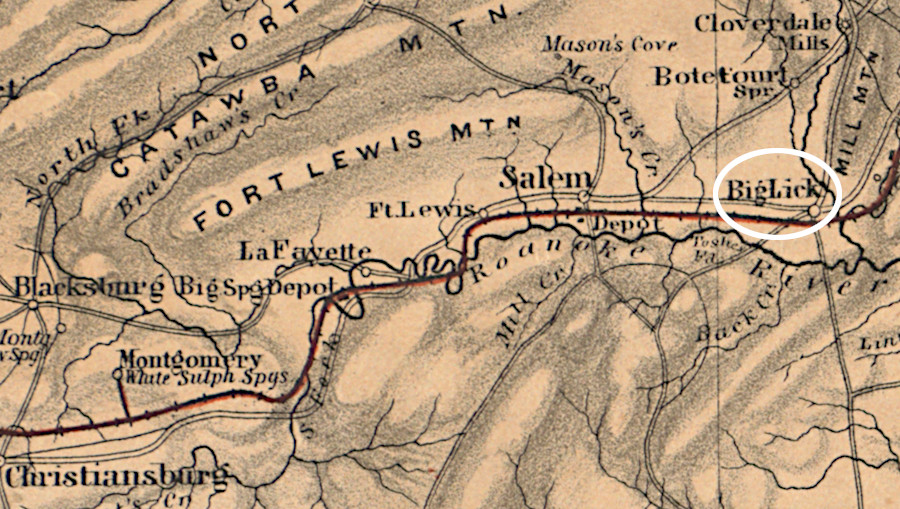
after the Shenandoah Valley Railroad joined the Virginia and Tennessee Railroad, Big Lick developed into Roanoke
Source: Norman B. Leventhal Map & Education Center Collection, Middle Virginia and North Carolina (1864)